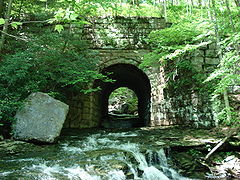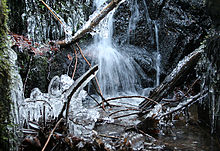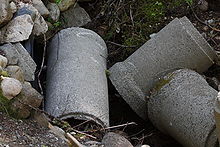- Culvert
-
 A large stone culvert (1888–89) in Blackwater Canyon, West Virginia. The structure formerly supported a railroad.
A large stone culvert (1888–89) in Blackwater Canyon, West Virginia. The structure formerly supported a railroad.
A culvert is a device used to channel water. It may be used to allow water to pass underneath a road, railway, or embankment. Culverts can be made of many different materials; steel, polyvinyl chloride (PVC) and concrete are the most common. Formerly, construction of stone culverts was common.
Contents
Types
Precast concrete culvert segments
Culverts come in many shapes and sizes, including round, elliptical, flat-bottomed, pear-shaped, and box. They vary from the small drainage culverts found on highways and driveways to large diameter structures on significant waterways or supporting large water control works. The latter can comprise large engineering projects.
There are three primary materials that culverts are made out of: steel, precast concrete, and polymer (plastic).[1] They can also be built as a hybrid between steel and concrete, for example an open-bottom corrugated steel structure on concrete footings, or a corrugated steel structure with a concrete "collar" around the ends.
When boxes or pipes are placed side-by-side to create a width of greater than twenty feet, the culvert is defined as a bridge in the United States. This is a requirement of the federal bridge inspection standards and ensures that the culvert is inspected on a regular basis.[2]
Minimum energy loss culverts
In the coastal plains of Queensland (North-East Australia), torrential rains during the wet season place a heavy demand on culverts. Further, the natural slope of the flood plains is often very small and little fall (or head loss) is permissible in the culverts. G.R. McKay and C.J. Apelt developed and patented the design procedure of minimum energy loss culverts waterways which yield small afflux. Apelt presented an authoritative review of the topic (1983) and a well-documented documentary (1994).
A minimum energy loss culvert or waterway is a structure designed with the concept of minimum head loss. The flow in the approach channel is contracted through a streamlined inlet into the barrel where the channel width is minimum, and then it is expanded in a streamlined outlet before being finally released into the downstream natural channel. Both the inlet and outlet must be streamlined to avoid significant form losses. The barrel invert is often lowered to increase the discharge capacity.
The concept of minimum energy loss culverts was developed by Norman Cottman, shire engineer in Victoria (Australia) and by Professor Gordon McKay, University of Queensland (Brisbane, Australia) during the late 1960s.[citation needed] While a number of small-size structures were designed and built in Victoria, some major structures were designed, tested and built in South-East Queensland.
Forestry
 Winter treasure trove under the culvert on a sub zero morning
Winter treasure trove under the culvert on a sub zero morning
In forestry, proper use of cross-drainage culverts can improve water quality while allowing forest operations to continue.
Accidents
Accidents with a culvert can occur if a flood overwhelms it, such as with the Jacobs Creek Flood of 2003, or disrupts the road or railway above it, such as with the Bethungra accident of 1885, which killed seven people.
If a culvert made of steel is not properly galvanized, the culvert can eventually collapse, again disrupting the road or railway above it. This happened at a culvert near Gosford, New South Wales in 2007, killing five.[3]
See also
- Borda–Carnot equation
- Drainage
- Low water crossing
- Sewer
- Siphon
- Storm drain
- Subterranean river
References
- ^ Culvert Pipe, "All About Culvert Pipe", October 29, 2010.
- ^ Questions and Answers on National Bridge Inspection Standards, FHWA, "What is a bridge?", June 21, 2005.
- ^ "Gosford Shire culvert washaway". The Sydney Morning Herald. June 14, 2008. http://www.smh.com.au/news/national/culvert-inquest-delayed-as-engineer-sails-away/2008/06/13/1213321620640.html.
External links
- Culvert Technology May Help Young Salmon Muscle Their Way Upstream — Article about the impact of culverts on salmon migration
- Culvert fact sheet — Information produced by Canadian Department of Fisheries and Oceans
- Bottomless Culvert Scour Study — FHWA culvert research
- Design of Road Culverts for Fish Passage Washington Department of Fish and Wildlife guide to designing and constructing fish migration friendly culverts
- More than 50, freely available, published research articles on culvert design, culvert hydraulics and related topics by Professor Hubert Chanson, Department of Civil Engineering, University of Queensland
- Hydraulics of Minimum Energy Loss (MEL) culverts and bridge waterways
Categories:- Culverts
Wikimedia Foundation. 2010.


